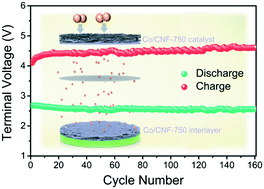Dual-functional 3D carbon fibers decorated with Co nanoparticles and Co-Nx sites for rechargeable aprotic Li–O2 batteries†
Abstract
Aprotic Li–O2 batteries possess extremely high theoretical energy density among all existing rechargeable battery systems. Thus, they are considered one of the most potential next-generation energy storage devices. Nevertheless, the lithium (Li) dendrites at the anodic side and the sluggish oxygen reduction reaction (ORR) and oxygen evolution reaction (OER) kinetics at the cathodic side of Li–O2 batteries greatly limit their practical applications. Herein, we put forward a dual-functional carbon nanofibrous skeleton decorated with Co nanoparticles and Co-Nx sites to ameliorate the electrochemical behavior of both anode and cathode in Li–O2 batteries. The synergistic effect of Co nanoparticles and Co-Nx sites could convert carbon fibers from lithiophobic to lithiophilic, which is beneficial to decrease polarization and moderate the dendritic formation at the Li metal anode. Moreover, Co nanoparticles and Co-Nx sites as active sites can promote the ORR and OER processes (especially the OER process) at the cathodic side. Accordingly, Li–O2 batteries composed of Co/CNF-750 cathodes and Co/CNF-750 interlayer-modified Li metal anodes displayed a low discharge-charge gap of 1.004 V and long cycle life of 160 cycles under a limited capacity of 500 mA h g−1 at a current density of 200 mA g−1. This work offers an effective strategy to simultaneously deal with barriers both in the O2 cathode and Li anode for the application of Li–O2 batteries.



 Please wait while we load your content...
Please wait while we load your content...